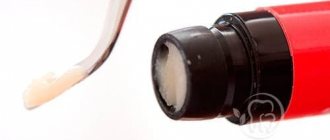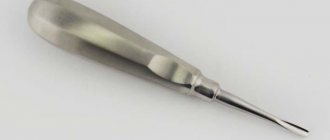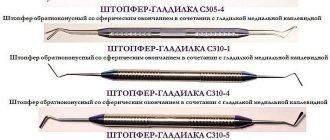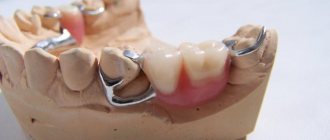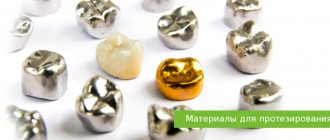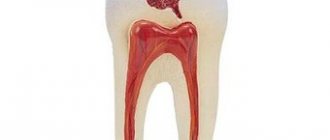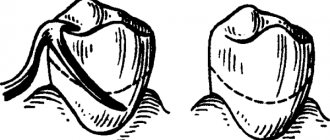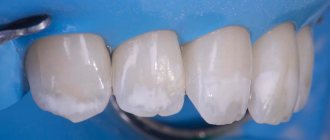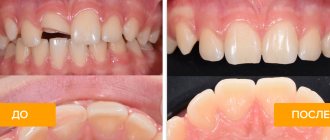General characteristics of the material
Dental cement
It contains powder and liquid, when mixed, a paste-like mass is formed.
Dental glass is used to mix dental cement .
An accompanying attribute is dental glass for mixing cement, available without a hole, with 1, 2, 3 holes
During the hardening process, the mass begins to harden and becomes like stone. Hardening occurs as a result of the components entering into a chemical reaction.
The main indicators that high-quality dental cement
, the following:
- mixing time;
- work time;
- curing time.
Mixing time refers to the period of time recommended for preparing the solution. Typically this figure is 90 seconds , and it is not recommended to exceed it.
The time during which the doctor must have time to apply the mixture to the tooth and model the filling is called working time. Each manufacturer of dental cement has its own characteristics, but the average varies from 4 to 10 minutes .
The period allotted for hardening of the cement mass also varies among manufacturers. Sometimes it can take a week for the ingredients to react and cause hardening. An important role in the setting of the material is played by the temperature and mixing proportions of dental cement.
with liquid.
Types of dental cements
Cements for dentistry are classified depending on their composition. The most familiar and old option involves a base of zinc phosphate, which still has excellent characteristics. Moreover, the material is relatively inexpensive.
But with the development of medicine and technology in general, modern composite cements are increasingly used in dental treatment.
Glass ionomer compositions
A universal substance used to create a temporary filling. The composition fills the tooth or part of it for a certain period, after which it is removed for further treatment.
The composition of the substance includes liquid in the form of polyacrylic acid and glass powder with fluorine.
Zinc phosphate cement
The oldest type of sealant used to form temporary fillings, secure dentures and create bases for crowns. Consists of zinc oxide and a solution of phosphoric acid with the addition of metal ions.
This type of cement is easy to form, hardens quickly, but is toxic to the dental pulp.
Silicate cement
By analogy with other cements, this composition is produced in the form of a set of liquid and powder. The liquid can be a solution of phosphoric acid, aluminum oxide hydrate or zinc oxide. The powder consists of oxides of silicon, potassium, aluminum, calcium and sodium fluoride.
The substance makes it possible to obtain high-strength permanent fillings, including for frontal teeth. The composition irritates the pulp, so an insulating gasket will be required. In addition to forming a filling, cement also has anti-caries properties.
Production of filling material
When developing a high-quality mixture for use in dentistry, manufacturers strive to ensure that its composition closely resembles the natural, inherent component of the tooth. For this purpose, additives are used that divide dental cement.
into several types:
- phosphate;
- polycarboxylate;
- polymeric;
- silicophosphate;
- glass ionomer.
Each subtype of cement is used in certain cases of oral treatment. The phosphate type is used for filling teeth with increased chewing load; polycarboxylate solution is characterized by rapid hardening. Polymer cement does not leave gaps between the gums; the silicophosphate type is good for its increased plasticity properties, and the glass ionomer solution is hypoallergenic and color resistant.
From the family of dental cements: Silicin Plus, Cemilight, Cemion, Uniface-2...
When contacting your dentist, ask him what materials are used to treat your tooth.
You can also choose the type of cement yourself, having previously studied its features and consulted with your dentist about the advisability of using it. Moscow metro station Zvezdnaya, Danube Avenue, 23
Compound
Any dental cement consists of a special liquid substance and powder. After mixing, the substances change from a liquid form to a solid state, similar to construction cement.
Now clinics use different types of cements, differing in their characteristics and performance indicators. The choice in favor of one composition or another is made based on the specifics of the work being performed and the requirements for the final result. To process the substance, the dentist uses spatulas and a dental mirror, which allows him to examine the base being formed from different sides.
Composite cement for fixation of crowns and dentures
This is a universal material in terms of use. After all, one of the key advantages of composite cement is that it is used in a wide variety of clinical situations.
Application
- Permanent fixation of a wide variety of ceramic products (crowns, veneers, lumineers).
- The best choice when installing various pin structures.
- Prosthetics of any kind, if the patient does not have increased tooth sensitivity, etc.
Properties
- Record strength.
- High adhesiveness.
- Great aesthetics.
- Resistant to saliva and other liquids.
- Risk of developing allergies.
ATTENTION : Doctors do not recommend the use of composites when installing crowns, etc., for people who have an increased tendency to secondary caries, as well as high enamel sensitivity.
A little history
What was not used as filling materials until the appearance of the first phosphate cement in 1832. The ancient Romans filled carious cavities with pieces of lead, the Mayans - with a mass of calcium phosphate, the Arabs - with a mixture of mastic, alum and honey, the Italians - with sheet gold, the French - with tin and silver paste (a mixture of silver and mercury).
Moreover, the word “cement” has always served as a designation for the purpose of the material.
The phosphate cement powder contained calcium oxide, and the liquid contained phosphoric acid.
Conclusion: what to choose?
Based on the results of everything said above, we can conclude that there is no ideal method of fixing crowns, but the optimal one will be the one that best suits a particular patient, provided that it is chosen by a professional based on objective factors. In addition, competent and careful adherence by the orthopedist to the technology will help mitigate any shortcomings and avoid negative consequences.
The VivaDent dental clinic employs just such professional dentists - qualified, experienced and competent, which means that no matter how the crowns are installed on your implants, it will be implemented flawlessly.
In what cases is it advisable to install on cement?
- Complete, partial edentia;
- single restoration;
- angulation of implants, during which high aesthetic and functional indicators become impossible;
- several designs with non-parallel mesio-distal or vestibulo-lingual angulation;
- the patient's desire to choose this method himself.
Cement fixation is possible:
- with a height of the upper part of the abutment of 5 mm or more;
- when the height of the attached gum around the structure is at least 3-5 mm;
- if the bone wall volume around the implant neck is at least 2-2.5 mm;
- with a crown-to-body height ratio of at least 1:1.5;
- antagonist teeth are in the correct position.
Strong connection with tooth tissues and no microleakage
A strong connection of cement with tooth tissues is necessary to ensure retention of a fixed prosthetic structure throughout the entire service life of the crowns [18,33], and the low permeability of cement helps prevent the occurrence of microleakage. Moreover, as a result of exposure to thermocyclic and chewing loads, some cements change their original properties and structure [13]. An important property of cement is its resistance to these influences. According to a number of authors, composite cements are among the most reliable in terms of this indicator [20,25,34].
S. Abo-Hamar et al. (2005) conducted a comparative laboratory study studying the shear strength of different types of cements with tooth tissues (enamel and dentin). High values of the bond strength of SCC were revealed (dentin - 10.8 MPA, enamel - 14.5 MPA) compared to GIC (dentin - 4.1 MPA, enamel - 6.1 MPA). In addition, a more pronounced negative effect of thermocyclic loads on the GIC was found compared to the SCC.
It is no coincidence that in order to increase the retention properties of crowns in cases where the height of the tooth core is low or the preparation is carried out with a significant taper, the use of composite cements is recommended [16,32,55].
Recently, much attention has been paid to the problem of microleakage under fixed prosthetic structures; even a new term “nanoleakage” has been introduced [38]. Permanent luting cement plays an important role in microleakage. The use of SCC provides more reliable and tight isolation of the tooth core compared to conventional GIC and GIC modified with polymers, which reduces the likelihood of microleakage under crowns [11,23,36] (Fig. 17-22).
| Rice. 17. Single crowns on the model | Rice. 18. One of the crowns was supported by an implant | Rice. 19. Various materials were used to make crown frames |
| Rice. 20. The chewing surface of the crowns recreates the anatomical features of a given group of teeth | Rice. 21. To fix the crowns, Permacem 2.0 cement (DMG, Germany) was chosen, which has high adhesion to tooth tissue, metal and zirconium oxide | Rice. 22. View of the finished work in the oral cavity |
Polycarboxylate dental cement for dentures and crowns
The main component is specially processed zinc oxide, without residual products, which reacts quickly with polyacrylic acid.
And the liquid part contains water and polyacrylic acid.
Polocarboxylates are characterized by:
- Lowest adhesiveness and strength.
- Excellent biocompatibility.
- Almost zero chance of developing allergies or irritation.
- Creating a thin layer of composition.
- Additional prevention of caries.
REMEMBER : Polycarboxylate cement for fixing crowns is ideal for fixing single crowns with increased tooth sensitivity. For all other clinical situations, there are better options.
Features of cement fixation
Before cementing, it is necessary to take an x-ray and carefully remove any remaining temporary dental adhesive. Cementing makes it possible to circumvent a number of limitations of the screw type of fastening:
- low occlusal stability;
- difficulty in manufacturing restorations with passive fitting.
There are also other features:
- soft tissues are mainly supported by the abutment;
- the crown is seated in such a way that its edge is at the same level or slightly apical to the gingival margin.
Glass ionomer cement for fixation of crowns and fixed dentures
The liquid part of glass ionomer cement is represented by polyacrylic acid, and the powder part is not similar to those described in this material.
Aluminosilicate glass contains a high fluorine content.
Application
- Ideal for cases where the risk of developing caries due to the release of fluoride is increased.
- It has proven itself excellent among patients with moderate tooth sensitivity.
- Time is not a very useful factor when fixing long bridges.
Properties
- Excellent prevention of caries.
- Very thin film.
- Low risk of developing allergies and pulp damage.
- With not very high strength, high adhesion.
PLEASE NOTE : This material cures slowly and is very dependent on moisture.
Postoperative sensitivity
A peculiarity of working with vital teeth (Fig. 11-16) is the occurrence of postoperative sensitivity after fixation of permanent crowns or covering ceramic inlays. In this case, one of the possible causative factors may be cement for fixing fixed prostheses [46]. Errors when performing adhesive preparation of hard tissues of vital teeth before using composite cements can lead to postoperative sensitivity and even pulp death [3,40]. It has been established that the use of self-adhesive cements is characterized by a low incidence of postoperative sensitivity [14,44].
| Rice. 11. Initial clinical situation: secondary caries and hard tissue defects were found on vital teeth after removal of old stamped crowns | Rice. 12. After treatment of caries, the core part of the teeth was restored with double-curing core material LuxaCore Dual (DMG, Germany), while the vitality of the teeth was preserved | Rice. 13. View of the teeth before taking an impression, retraction thread is placed around the teeth |
| Rice. 14. Fragment of a two-stage two-layer impression with a detailed display of the boundaries of the preparation and the periodontal sulcus | Rice. 15. Metal-ceramic and solid-cast crowns on the model | Rice. 16. Crowns after fixation with permanent cement. SCC was chosen to prevent the occurrence of postoperative sensitivity |
D. Saad et al. (2010) found a lower incidence of postoperative sensitivity with self-adhesive cements compared to classical composite cements that require etching and preliminary adhesive preparation. Of interest is a study conducted by CA de Souza Costa et al. (2008), who compared the effect on the dental pulp of two SCC cements and a composite one with the etching stage and adhesive preparation. On 32 premolars to be removed for orthodontic reasons, cavities were formed and ceramic inlays were fixed using the above cements, after which these teeth were removed (after 7 and 60 days) and a histological examination of the dental pulp was performed. It was found that the use of traditional composite cement with the stage of etching and adhesive preparation is accompanied by a more pronounced effect on dental pulp tissue compared to SCC.
N. Denner et al. (2007) conducted a comparative study of the incidence of postoperative sensitivity in vital teeth after fixation of full crowns using 2 types of cements: glass ionomer (GIC) and SCC. 120 crowns were installed in 30 patients, and a comparative analysis of such an indicator as postoperative sensitivity after 24 months did not reveal a difference in the use of both cements. M. Blatz et al. (2013) studied the incidence of postoperative sensitivity in vital teeth after fixation of full crowns using SCC and polymer-modified GIC. The incidence of postoperative sensitivity was lower when fixing crowns with SCC compared to GRC modified with polymers.
